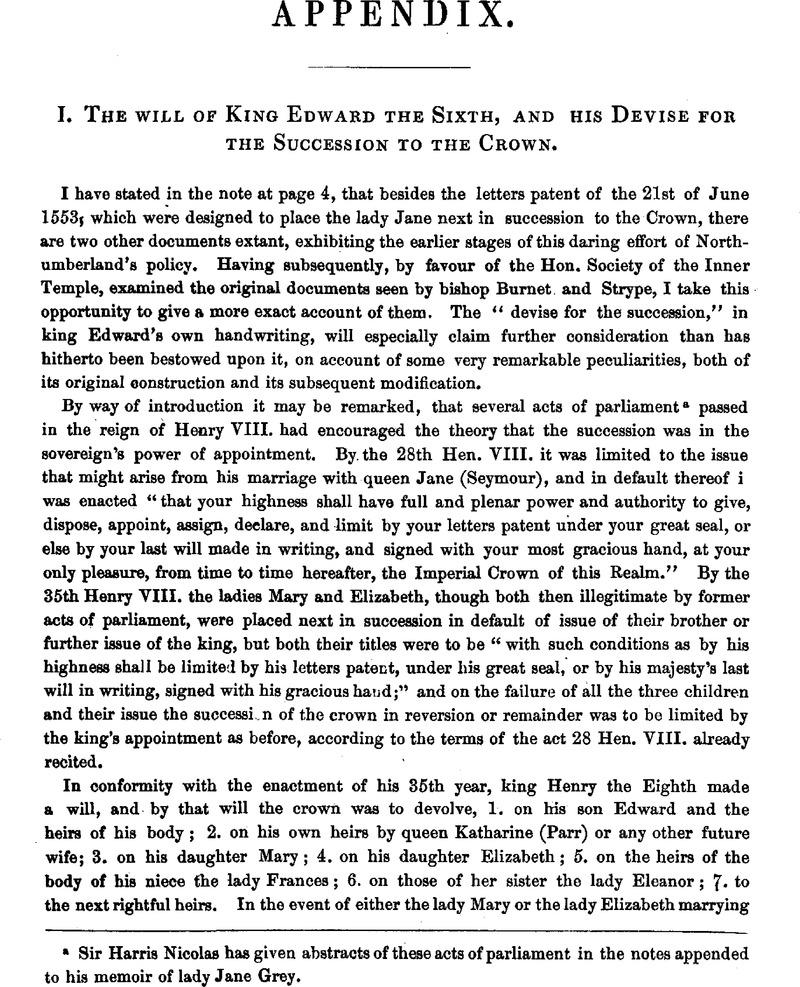No CrossRef data available.
Published online by Cambridge University Press: 23 February 2010

page 85 note a Sir Harris Nicolas has given abstracts of these acts of parliament in the notes appended t o his memoir of lady Jane Grey.
page 86 note a They are not even named in the king's devise: but in the final settlement, or letters patent, their title as founded on their father's will is first recited, and then declared inadmissible on these three grounds,—1. their illegitimacy; 2. their being of half-blood to the king; 3. the probability of their marrying a stranger born out of the realm.
page 86 note b Henry the Eighth had already preferred the descendants of his aunt the queen of France to those of her elder sister the queen of Scots, who were considered as debarred from the inheritance as aliens by birth. In contrast to which, it was “called to our remembrance” (i. e. of king Edward) that the daughters of the lady Frances and the lady Eleanor were “of the whole blood and naturall-born within the realm.”
page 87 note a The lady Frances was born 16 July 1517 (Lodge's Illustrations, i. 27.) She was now therefore thirty-six; and lord Orford was wrong in supposing her “not past thirty-one,” in his remarks cited by Nicolas, Memoir of Lady Jane Grey, p. cviii.
page 87 note b Printed in Strype's Life of Cranmer, Appendix, No. lxxiv., and in the Parker Society's edition of Cranmer's Works, vol. ii. p. 442.
page 87 note c References to these have been already given in p. 4.
page 87 note d Among various proofs of this feeling see particularly the “Epistle of poor Pratte,” printed hereafter. We find Noailles attributing queen Jane's ill-success rather to the people's hatred of the overbearing duke than to their love for Mary toutes ces choses sont advenues plus pour la grande hayne que l'on porte a icelluy due, qui a voulu tenir un chacun en craincte, que pour l'amitie que l'on a a ladicte royne.” Ambassades; ii. 80.
page 88 note a The document says seals also, but the ‘seals’ were not added (unless, indeed, it was executed in duplicate).
page 88 note b The French ambassador Noailles, who was in the confidence of the Protestant party, wrote home to his master on the 26th June) that the king had made his will nine days before—viz. on the 17th, four days before the actual date of the letters patent. Noailles had probably received an account of the council meeting at which the king propounded his devise. — 26 June 1555. “Il y a aujourd'huy neuf jours que le roy vostre bon fils et frere feit son testament, par lequel il ordonne et veult, par sa derniere volunté, que sa couronne tumbe a Jeanne de Suffolck, comme je vous ay cy-dessus escript, [no former intimation of the fact or intention is preserved in Noailles's letters,] et le parlement de Hoestcemestre a esté remis jusques a la fin du mois de Septembre, qui est, comme je pense, pour confirmer sesdictes dispositions.” Ambassades de Noailles, ii. 49.
page 89 note a “she,” i. e. the lady Frances (duchess of Suffolk), whose three living daughters, Jane, Katharine, and Mary, have now been enumerated.
page 89 note b “the her eldest daughters,” sic MS. probably for then her eldest daughter,—i. e. the lady Jane. There is nothing in the letters patent corresponding to this clause; for it was rendered unnecessary when the arrangement had been admitted that the lady Jane should immediately succeed in the event of her mother having no son at the time of King Edward's decease. Still, as appears from the king signing “in six several places,” there were six paragraphs in the fair copy of the devise.
page 90 note a This clause, though erased in the king's draft, will be found retained in the letters patent, but the council was to consist of thirty instead of twenty members.
page 102 note a The words in italics are erased, and those in the parenthesis substituted.
page 102 note b This, as well as in the preceding item, alludes to a non-executed clause in the will of his father King Henry: who, after directing his own tomb at Windsor, which was then “well onward and almoost made therefore alredye, with a fayre grate about it,” to he completed, adds, with reference to two of his predecessors interred in Saint George's Chapel, “Also we will that the tombes and aultars of king Henry the vj. and also of king Edward the Fourth, our great-uncle and graunt-father, be made more princely in the same places where they now be, at our charges.” All these directions were finally disregarded.